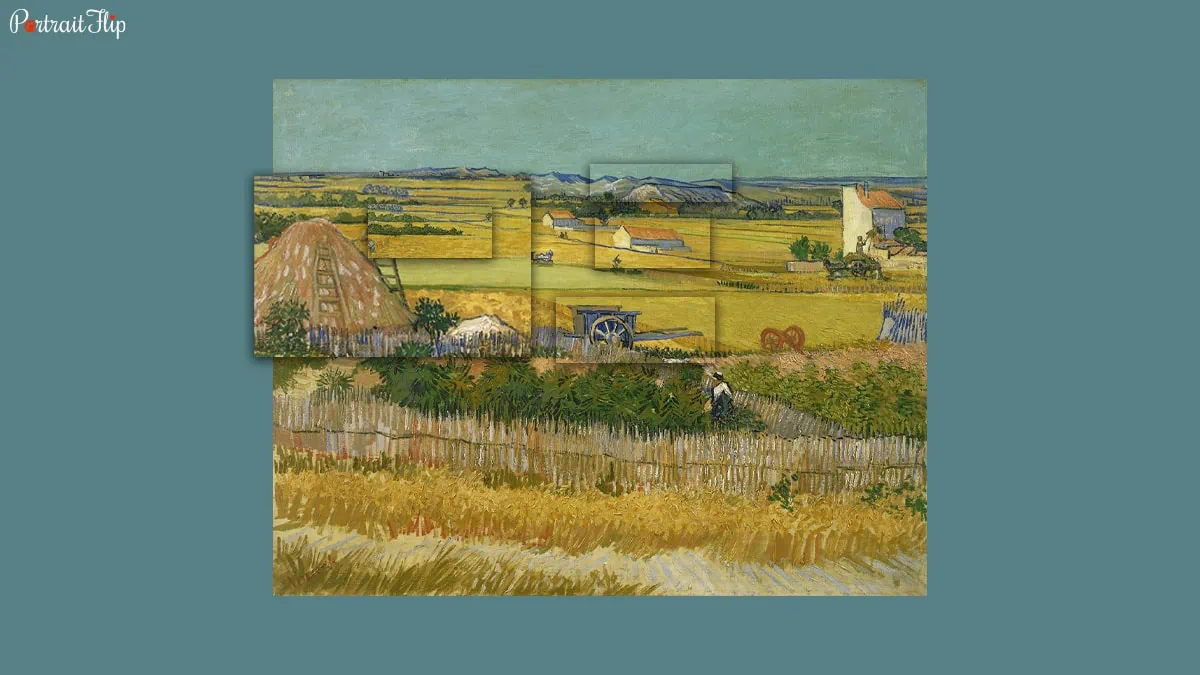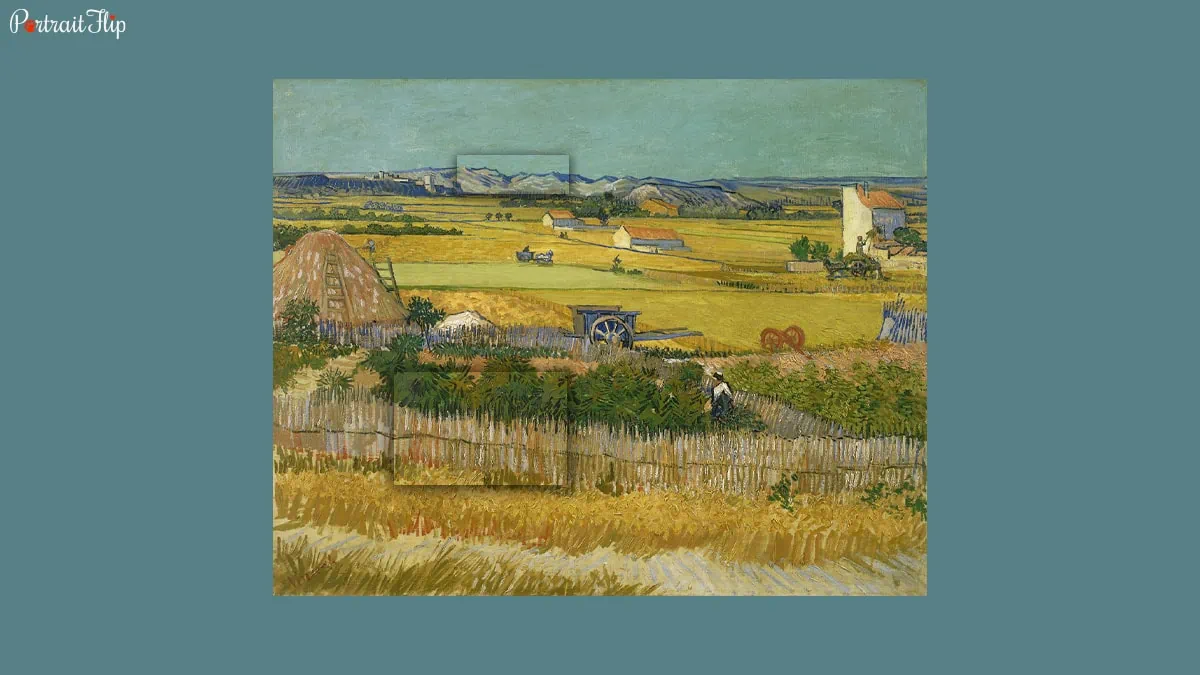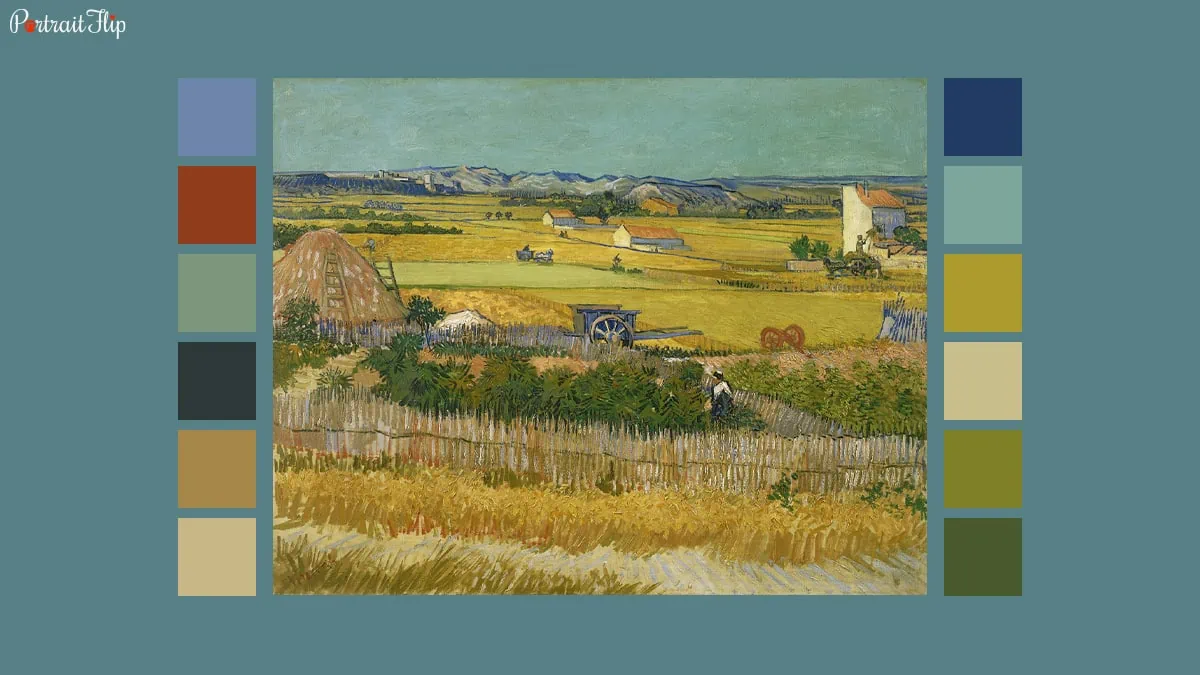How would you describe a painting that portrays the subtle and serene landscape of the Little Alps?
Well, that’s The Harvest by Vincent Van Gogh in a nutshell.
The Harvest by Van Gogh was produced in 1888 and is a testament to Van Gogh’s prime period.
Van Gogh attempted to portray a premier outlook of the European pasturelands through these Harvest paintings.
It happens to be one of the most illustrious and artistically vibrant works of all time.
Van Gogh’s landscape paintings always embody a certain complexity in their core elements.
Paintings like Sunflowers and Starry Night by Van Gogh depict his expertise in portraying complex and layered themes on the canvas.
However, The Harvest painting is an example of Van Gogh’s proficiency in creating layered compositions with a simple concept.
With that being said, let’s dive a little deeper into understanding The Harvest painting by Van Gogh without contemplating anymore!
Table of contents
Historical Context
Depicting a scene of harvest cultivation, The Harvest by Van Gogh is a visual representation of how French pastures turn during the harvest or summer season.
Since it’s an artwork painted in the summer of 1888, it integrates the element of scorching heat visually.
Despite being a Dutch native, Van Gogh was a huge fan of French landscapes.
To be specific, Arles in the South of France was his well-cherished spot. Hence, it is the best choice to capture different stages of harvest.
The fine composition of The Harvest implies that it would’ve taken an ample amount of time to create it.
But Vincent Van Gogh took only a couple of days for painting the harvest.
Isn’t the harvest landscape astonishing?
There are multiple instances related to this painting that’ll keep astonishing you! Plus, you can also get yourself some of the coolest Landscape colored pencil portraits, that too handmade!
Symbolism in The Harvest
Before decoding the symbolism in the Harvest painting, we need to get acquainted with the different elements present in the painting.
This Van Gogh landscape painting contains elements of the pre-modern European era.
The season implied in this artwork happens to be the harvest. Hence, Van Gogh mentioned various elements from the respective season:

Haystacks: They depict the presence of cultivated crops
Small Huts: They signify the residential presence of farmers in that field
Carts: They show the movement of farmers in that area while cultivating the crops.
Alpellies: Harvest at la crau, with montmajour in the background, symbolizes the mesmerizing beauty of the landscape. It has been captured in many landscape acrylic paintings.
Crop fields of different sizes: They symbolize the transition of the season.
Apart from these elements, there are a few more rudiments that portray symbolism in The Harvest painting:
- Van Gogh has sprayed daubs of color deliberately to give this painting the essence of Post-impressionist artwork with figurative realities.
- The use of yellow pigment with a blend of different colors is quite evident. It has been done to symbolize the variety of crops in the Harvest artwork
- Another subtle element happens to be the blue cart kept right in front of a haystack. It speaks about the characteristics of European farming back in the day.
- Despite being a post-impressionist artwork, the composition of the Harvest painting happens to be pretty sharp and detail oriented.
Composition

Van Gogh has been very consistent in his compositions. Be it complex paintings like Starry Night or straight-forward creations like his other Van Gogh paintings.
He always introduced something fresh and distinctive through his paintings.
Similarly, The Harvest painting also has a distinguished style of painting.
Everything about this post-impressionist artwork seems very intriguing and interesting at a glance.
From the landscape with houses by Van Gogh to the Little Alps, let’s discuss the nuances of this painting with an in-depth perspective:
- Variety of Brush Strokes: Van Gogh was indeed an artistic genius. He had command over various styles of painting. Synonymous can be seen in the Harvest painting. He has deployed different types of brush strokes for different elements. For instance, haystacks have a smoother stroke in comparison to crop fields or boundaries.
- Spacing on the canvas: Almost 3/4th of the canvas accommodates all the elements of the painting. Including the farming objects, the fields and the little Alps range. The rest 1/4th of the canvas is occupied by the mesmerizing blue sky.
- 3-D effect: Post-impressionist artworks weren’t really known for their three-dimensional perspectives. However, Van Gogh gave a brilliant 3-D touch to the Little Alps in the background. He created a double layered peak to make it appear as a 3-D object.
- The Perfect Blend: Just like paintings by Kandinsky, Van Gogh also had a huge fascination with creating a blend of colors while painting new artworks. Paintings by Van Gogh like The Harvest showcase his expertise in choosing colors for paintings. For example, he used bright yellow along with daub brown to give a contrasting effect.
Color Scheme

Do you know what the core rudiments of a painting are?
Well, one of them is the color scheme! It not only gives life to artists’ thoughts but also shapes the artist’s inspirations vibrantly on the canvas.
The Harvest painting by Van Gogh contains a very peculiar color scheme.
It accommodates different shades and colors along with their synonymous blends in contrast to the Harvest art:
Yellow: This is the most prominently used color in the Harvest painting. Van Gogh has used yellow to illuminate different portions of the crop field.
Green: Another prominent color in the Harvest painting happens to be green. It is used in a very obvious manner to highlight the lush green bushes scattered amongst the crop fields.
Blue: This azure pigment is evident in a few different elements. Starting from the sky to the carts and even the wooden fence beside the haystack, blue has given a very contrasting look to the overall composition.
White: A color that simplifies all the elements in any of the famous paintings around the globe. Its use in the Harvest painting is visible in coloring the huts with a few tints of yellow and brown.
Recommended Read: Guernica by Picasso
Inspirations behind Creation of The Harvest
Van Gogh became a resident of Arles in the 1880s. He conceptualized and painted most of his paintings there.
Being an avid observer of his surroundings, Van Gogh was very diligent while sanctifying snapshots of real life.
He has showcased an example of the same in The Harvest painting.
By painting a routine scene from the lives of French peasants, Van Gogh justified his visual grasping power on the canvas.
It is evident that Van Gogh was influenced by the lives of local French peasants.
He desperately wanted to present their grind in front of the world.
Inspired by Van Gogh’s works, many French painters even created landscape pencil portraits of The Harvest painting.
Suggested Read: Johannes Vermeer’s Paintings
Why should you have a copy of “The Harvest”?
There are innumerable awe-inspiring artworks in the world.
Most of them are testaments to different art movements and notions.
However, The Harvest painting stands out from the crowd in this case.
It happens to be an example of an intersection between post-impressionism and figurative art.
It’s a true emblem of the contrary nature of art!
The Harvest painting is a jewel in Vincent Van Gogh’s collection.
Who wouldn’t want to own it after getting acquainted with the real essence of this painting!
Purchasing The Harvest does not fall within everyone’s budget.
But we can provide an exact replica for just a few hundred dollars!
Conclusion
Artists like Van Gogh create time stamps for future generations.
Their paintings justify the essentiality of these art reforms with every nuance they contain.
Just like that, The Harvest painting also speaks about the lives of peasants and farmers in the Arles region of France.
The Harvest happens to be a painting of duality, and we don’t witness paintings of a contrary nature every day.
This painting is a treasure for us, and we should cherish it only that way!
Author’s Note
Hello readers,
I thank you all for staying till the end and reading my blog about the Harvest painting.
I hope my writing did justice to your curiosity and time.
We keep on producing such amazing and valuable content on a daily basis.
Subscribe to our YouTube channel and follow us on Instagram to stay updated on our content.
See you soon in the next blog!
FAQs
The Harvest painting is a visual representation of a farming crop field located in Arles, France. It includes different rural elements, like carts, haystacks, and the Little Alps in the backdrop.
Famous painter Vincent Van Gogh created the painting The Harvest.
A snapshot of routine life in a French crop field can be seen in the Harvest painting. Mainly, the process of crop harvesting is going on. The peasants are retrieving crops from the fields and stacking them.
Vincent Van Gogh painted The Harvest in 1888.






Wow, “The Harvest” by Van Gogh is truly a masterpiece!
This blog post provides fascinating insights into the painting,
delving into Van Gogh’s artistic techniques and the historical context surrounding the artwork.
The article’s detailed analysis helps deepen our appreciation
for Van Gogh’s talent and the emotional depth conveyed in his works.
Whether you’re an art enthusiast or simply curious about Van Gogh’s iconic pieces,
this blog post is a valuable resource that will enhance your understanding and admiration for “The Harvest.”
Thank you for the appreciation Alin Khan. I’m glad that my writing conveyed the profoundness of Van Gogh’s art to the readers.